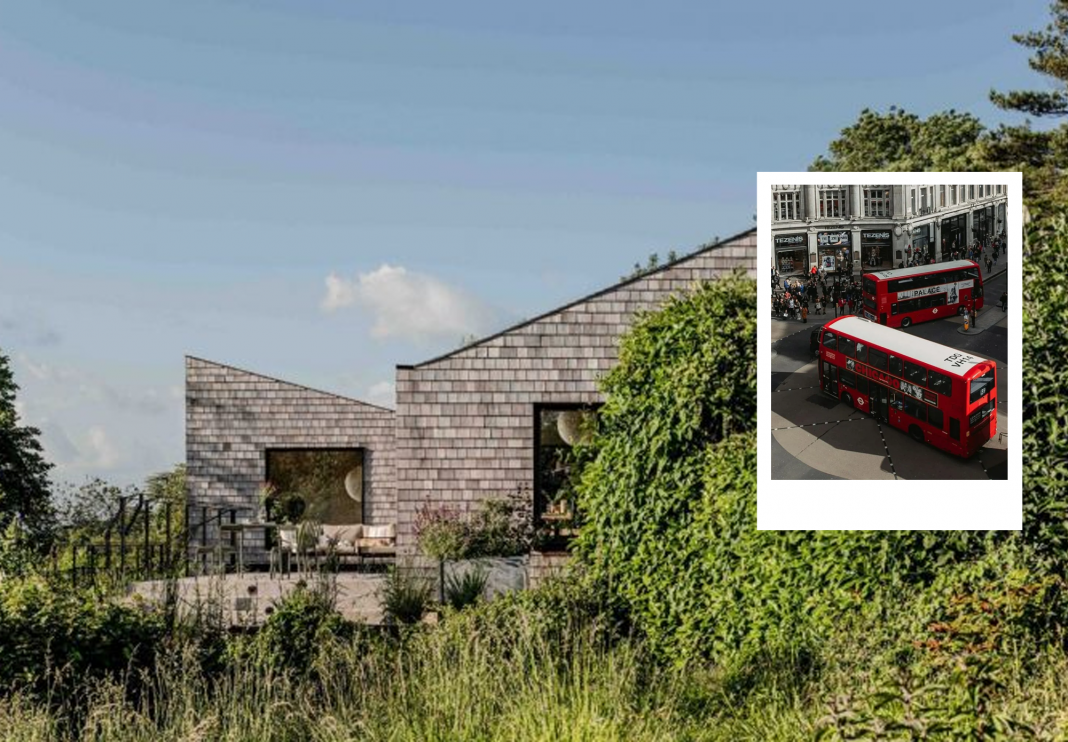This week’s conversations among design enthusiasts have been anything but dull. From the divisive kitchen counter in a reimagined Bath bungalow to the heated debate around pedestrianising London’s Oxford Street, and even a surprising wildlife twist at Google’s new London HQ—Dezeen readers are not holding back. Here’s a look at the design stories stirring up strong opinions.
A house of shingles and sharp opinions
Forgeworks’ renovation of a 1960s bungalow in Bath, aptly titled A House of Wood Shingle, has sparked animated debate, particularly over the home’s unconventional kitchen. The project re-clads the exterior with a rich skin of cedar shingles, evoking rustic warmth and character. Inside, bright colours liven up the once-muted mid-century interior—but not everyone agrees it works.
Commenter Ken Robertson admired the “nice proportions, nice palette, nice external textures,” but couldn’t quite digest the kitchen, asking, “what on earth happened with the kitchen surface?” Tom Roberts went further, concluding that “in the kitchen and hallway, more is definitely less.” HeywoodFloyd delivered perhaps the most scathing review: “That kitchen counter and backsplash are literally bonkers.”
However, some readers came to the kitchen’s defence. “The kitchen and a few inspired bright colours save this from the grey doom,” wrote user Jb, highlighting the interior’s punchy contrast with more restrained contemporary designs. Another reader, going by the name AlfredHitchcock, called the home “a very pleasing, relatively modest and simple house,” adding, “love the weathered shingles.” Clearly, the design’s departure from minimalism struck a nerve—with some applauding its character and others finding it jarring.
Oxford Street at a crossroads

While design disputes raged over countertops, another urban issue sparked equally passionate responses: London Mayor Sadiq Khan’s renewed push to pedestrianise Oxford Street. Chris D called the move “well overdue,” echoing a sentiment shared by Rd, who remarked, “once you’ve experienced it you’ll never go back. Every city should do this.” Supporters see the plan as a step toward a more walkable, people-focused capital, aligning with broader trends in urban design aimed at reducing car dominance and increasing public space.
Yet not everyone is convinced. AlfredHitchcock—this time weighing in on urbanism rather than architecture—argued, “Removing traffic from Oxford Street isn’t going to reverse 30 years of decline. All it will do is create an even tackier tourist trap.” They added, “absolutely no thought has gone into this scheme and its wider impacts,” suggesting that side streets and nearby areas may suffer from traffic overflow.
Even harsher was user Whateverandeveramen, who dismissed the plan with sarcasm: “Great – it will be even easier to access the dozens of money-laundering candy shops installed there.” The tension highlights a central issue in urban renewal: the balance between revitalisation and unintended consequences. Can pedestrianisation transform Oxford Street into a vibrant public space—or will it simply displace the problems elsewhere?
A wild twist on a London rooftop

From cedar shingles to concrete jungles, the third story catching readers’ eyes this week came with a bushy tail. Urban foxes have taken up residence on the rooftop garden of Google’s “landscraper” headquarters in King’s Cross, designed by BIG and Heatherwick Studio. Their presence has been interpreted in many ways—some serious, others tongue-in-cheek.
“It’s a sign of genuine ecological design,” wrote Dixie Normous. “Animals don’t fake habitat – so it’s a real compliment.” Baid Isle agreed, praising the building as “a good example of integrating natural features into the built environment.” Still, not everyone was thrilled. LoveYourHairHopeYouWin quipped, “Glad someone likes it, I guess,” while Apsco Radiales took a more radical stance: “Good! Animals are far better than most people.” Joe Public, offering a dry counterpoint, shrugged it off: “In other news, I saw a hedgehog in someone’s front garden a couple of weeks ago.”
The unexpected fox guests might seem minor, but the commentary reflects broader questions about the role of nature in contemporary architecture. Is ecological integration merely decorative, or can it create genuinely livable environments—for all species?
Commentary as critique

From controversial kitchen surfaces to pedestrian plans and rooftop ecosystems, this week’s reader feedback underscores how architecture and design continue to provoke strong emotions. Whether you’re drawn to Forgeworks’ bold use of colour, concerned about Oxford Street’s future, or cheering on urban foxes, one thing is certain: good design doesn’t just shape our spaces—it sparks conversation.
Have your say. Join the debate.



